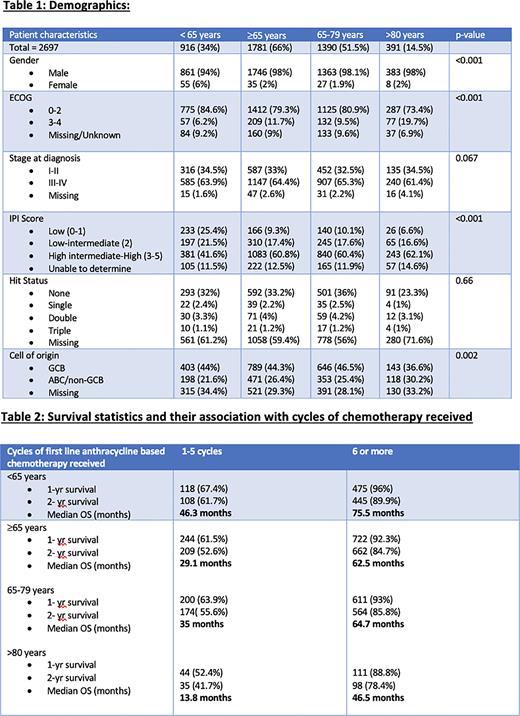SAN ANTONIO — The most common non-Hodgkin lymphoma is diffuse large B-cell lymphoma (DLBCL), and its incidence steadily increases with age, according to recent research.
“The elderly population diagnosed with DLBCL are a heterogeneous group with no standardized age cut-off in literature,” wrote a study team led by researchers from the South Texas Veterans Health Care System and the University of Texas Health Cancer Center, both San Antonio. “There is also a paucity of data regarding the treatment of elderly DLBCL patients due to lack of participation and/or inclusion in clinical trials.”
In a presentation at the most ASH Meeting and Exposition in New Orleans, the authors pointed out that the VHA is one of the largest integrated provider of cancer care in the United States and has a population which, on average, is older than the general U.S. population. They added that gave them “a unique advantage in exploring real-world outcomes in this elderly population.”1
The retrospective chart review involved 5,199 randomly selected patients with an ICD code for lymphoma treated within the VHA between Jan. 1, 2011, and Dec. 31, 2019. Data abstractors collected baseline patient and disease characteristics and treatment responses, and survival time was determined via electronic health record query on July 25, 2022.
Of the 2,697 patients meeting the inclusion criteria, two-thirds of the patients were 65 and older. Of those, 51.5% were 65-79 years old, and 14.5% were older than 80. “Though ECOG status decreased with increasing age, more than 2/3rd of the patients within each of the above subgroups had a preserved ECOG score of 0-2,” the authors advised, adding that activated B cell {ABC} phenotype was statistically more common in patients older than 80 years when compared to those 65 and younger or 65-79. “No difference was seen in the distribution of double or triple hit status between the three groups,” they added.
The researchers reported that the percentage of patients that did not receive any treatment increased with age (3.2% vs. 6% vs. 20.7% in <65, 65-79 and >80-years groups respectively, p<0.001). Also decreasing with age was the number of patients receiving two or more lines of treatment decreased with age (10.2% vs. 7.5% vs. 2.3%, p<0.001).
“Across all age groups, R-CHOP remained the common first-line regimen (73.3%, 67.9%, 39.1%) with more proportion of the >80-years group receiving R-mini-CHOP (0.3% vs. 2.1% vs. 15.1%) when compared to the other groups,” the authors noted. “In terms of completion of first-line treatment(R-CHOP or R-mini-CHOP), patients <65 years were more likely to complete 6 cycles when compared to patients >65-79 and 80 years (73.9% vs. 67.8% vs. 59.8%, p<0.001).”
Still, they said that the overall median overall survival decreased with as age increased: 63.7 months in those younger than 65, 48.3 months in those 65-79 and 23.6 months in the older than 80 years age group. “Patients of all age groups, who received 6 or more cycles of first-line anthracycline-based regimen had almost double the duration of 1-, 2- year and overall survival when compared to patients who received ≤5 cycles,” according to the study.
“Veterans older than 65 years who are diagnosed with DLBCL present with a higher stage of disease, higher IPI score and ABC phenotype,” the authors concluded. “Amongst them, the very elderly patients older than 80 years old had the shortest survival along with low treatment initiation and completion rates despite comparable functional status at diagnosis.”
Yet, they added that those who were able to complete six or more cycles of first line R-CHOP/R-mini-CHOP reached nearly double the duration of median OS when compared to veterans receiving less than six cycles of chemo-immunotherapy.
“Given that the incidence of DLBCL has been increasing over the age of 65 years, therapeutic approaches that optimize treatment efficacy while minimizing toxicity are needed,” the researchers explained. “ With the advent of genomic profiling and identification of molecular abnormalities in DLBCL, novel antibodies or small molecules with relatively low toxicity can increase tolerance in upfront setting, leading more elderly patients towards completion of necessary lines of treatment and improved overall survival.”
- Ananth S, Kaur S, Al-Abavechi A, Blaize JP, et. al. Treatment Patterns and Survival Outcomes in Elderly Veterans Diagnosed with Diffuse Large B-Cell Lymphoma. Presented at the 64th Annual ASH Meeting and Exposition; December 2022; New Orleans, LA

